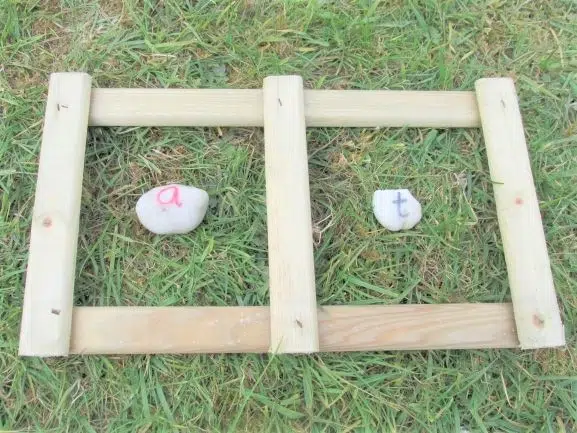Blending and segmenting are very closely linked skills, and yet they are also kind of opposites. Both are really important to early phonics, and are needed for children to start reading and writing simple words.
But what’s the difference between blending and segmenting?
Blending is a skill needed for reading. Segmenting is used for writing. Whereas blending involves merging the phonemes (sounds) you hear together to make words, segmenting is the process of splitting words up into their phonemes.
That is the short answer, but there’s a bit more to it than that.
Over a ten year career working with children aged 3 to 5, I have found there are several fundamental differences between blending and segmenting, and I’m going to describe in full what those are for you, as well as throw in a lot of extra top tips as well – so stay tuned!

The Differences Between Blending And Segmenting
1.They Are Opposites
Blending is probably the most important skill of early reading. It is the skill of ‘blending’ or merging the sounds that you hear.
There are two main types: oral blending which comes first, and then blending for reading.
Oral blending is hearing verbally a word broken up into sound talk, e.g. the word ‘sat’ split up as ‘s-a-t’, and you are able to mix the sounds together the make the word ‘sat’.
When children are able to at least have a go of this with support, they will be ready to have a go of blending for reading. To do this, they will also need to learn a few phonemes (sounds), usually s, a, t, p, i, n coming first. The process then is that when shown a word, they point to each phoneme in turn and sound it out, e.g. ‘t-i-p.’ Then they will hopefully be able to ‘blend’ the word, i.e. hear that it says ‘tip’.
Segmenting is in many ways the opposite of this process. If you want to read the full description of what segmenting is and how to tewach it then check this out.
Segmenting is probably the key skill of early writing.
Like blending, there are two main types: oral segmenting which children begin to learn first, and then segmenting for writing (which is actually pretty similar to oral segmenting).
Oral segmenting is quite simply getting a word such as ‘tap’ and being able to split it up into its phonemes verbally – ‘t-a-p.’
Segmenting for writing is pretty much the same skill. You split up a word into sounds, but you write each sound as you say it.
2.Ways They Are Taught
Different games are required to teach the two types of skills.
Some excellent games to teach oral blending include:
- Use a puppet to make up a sound story. If you’re looking to get a puppet, then my number one puppet ever is this large monkey puppet that you can find on Amazon here:

- Dress The Baby! Have a toy baby and some clothes. Say things to the children like ‘Put on the h-a-t’ and see if they can put the right piece of clothing on
- Grumpy Cat. Have some kind of angry looking toy (they love my grumpy cat toy). Get the children to stand up, and the grumpy cat says things like ‘Put your hands on your ch-ee-k!’

There are so many fantastic games you can use with puppets to cover all sorts of areas of the curriculum, and if you want to find out 22 of the best strategies then check this out.
On the other hand, some great oral segmenting games would include:
- Using a robot to segment words in ‘robot’ talk. This involves the children bending their arms at ninety degrees at the elbow and moving them like robot arms, whilst they say things like ‘s-a-t. Sat!’ If you’re looking for a robot toy, my favourite is definitely this one.

- Dance segmenting. Do a simple dance move to music, whilst saying things like ‘p-o-t. Pot!’
- Three claps game. Get a word, and clap three times whilst saying the sounds, e.g. ‘D-o-g. Dog!’
Once again the teaching of segmenting is a whole art and a skill by itself, and if you want to find out the full nuts and bolts of how it’s done then go here.
I have written a whole aricle about the 17 best segmenting activities you can try out to get your children confidently using this skill.
3. Order You Teach Them
A common question that I have been asked a lot is which do you teach first – blending and segmenting? This is a really interesting question, and there appears to be no set answer from government advice in different countries.
My thoughts on it are the following…
I think it would be a mistake to start them both at the same time. This could be quite confusing for the children! I would start one of them about a month before the other and get a bit of momentum with that before going on to the other.
My personal preference is definitely to teach blending first. There are several reasons for that, including:
- Normally children are going to develop reading skills faster than writing.
- There is a natural sequence that is best to follow in early literacy. That is that children progress from speaking, then to reading, then to writing. That is the natural order to try to follow. It clearly makes sense to teach reading skills slightly before writing skills
- The emphasis of early phonics is much more on reading than writing.
If you want to find out the full reasons behind why I would teach blending first, I wrote an article about it which you can check out here.
Some Similarities
Whilst being different in many key ways, blending and segmenting are also very similar. So I thought I better mention a few similarities between the two also, along with some top tips that might come up when you teach them:
1.Children Will Be Ready For These Skills At A Similar Time
Developmentally, children will be ready to learn the skills of blending and segmenting at the same time. It is not the case that one is ‘harder’ than the other. The trick of course is working out when the right time is to start.
Typically speaking, most children will be ready to blend and segment when they can:
- Join in with simple listening games, some of which you can find in this article about the 21 best preschool circle time games.
- Have an awareness of rhythm and can successfully join in with simple rhythm games. If you are not sure what kind of rhythm games to try, then I recommend reading this essential guide to rhythm sticks games.
- Have developed at least a bit of awareness of rhyme and alliteration
- Know several songs, rhymes and chants
2. Usually Success Is Found In Both
It is very rare for a child to be great at blending but have no idea about segmenting (or vice versa).
Almost always they will get the idea of both more or less at the same time. Some children might have a slight issue with one and take slightly longer, but this will only normally be a matter or days or weeks (not months).
For example, some children might be OK to blend 3-letter words, but when they try to segment them they get the last sound wrong. This just takes a bit more practice – they are almost there, so keep going!
3.Issues Will Often Effect Both
Sometimes children will have an issue that will effect their learning of these two skills. Often it will effect both at the same time.
Here are some things to watch out for:
- Children with speech and language issues – Speech and language can have varying degrees of effect on early phonics. Some children can’t say many sounds clearly at all, but they can learn to read and write them. Even if they are not saying the words correctly, they know what they are trying to say.
- On the other there are children that are saying sounds incorrectly because they are also hearing them wrongly. This is more of a deep seated issue, and the main way round this is some kind of speech and language therapy. There may be several underlying issues, such as eye contact which can be taught through tese 12 games.
- Children saying the last sound wrongly. This might happen when they try to blend (where ‘pig’ becomes ‘pit’), or when they segment (and write ‘pit’ instead of ‘pig’). This is quite normal! This shows they are on the way to learning how to fully master the skill. The first process is hearing the initial sound in the word. After that some children seem to hear the last sound in the word, before they can later hear the middle sound. Others seem to hear first, then second, and lastly third after a bit more practice. With either of these issues – just keep going! They have got eighty per cent of the way there, and just need to give it one final push!
- Children guessing. This is by far the most serious problem! Try to avoid this at all costs (which can be easier said than done).
Some children will just completely make up the word – for example, sound out the word ‘p-i-t’, and then say ‘jam!’ (or something else completely unrelated).
Oral blending and segmenting games are the answer for these children. It is best to do them daily, and make them as fun as possible! Some children take longer, and that is perfectly normal.

4. They Are Central To Early Phonics
They both really are a ‘make or break’ skill. There are so many children that learn loads of sounds but then get completely stuck because they can’t do anything with them.
It is the skills of blending and segmenting that piece the whole process together. You can know every single letter and sound in the whole English language, but without these two skills it is totally pointless.
The Differences Between Blending And Segmenting In A Nutshell
- They are opposites
- Blending is for reading, and segmenting for writing
- Blending merges sounds, and segmenting splits words up into sounds
Conclusion
There has been a lot of research done about the indisputable impact of early phonics teaching (Source), and blending and segmenting really are central to this – I can’t emphasize that enough!
If you’ve found this useful, then I really would recommend checking out a few of these articles…
